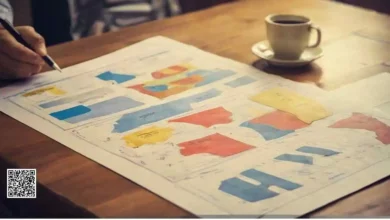Six Thinking Hats Brainstorming Technique

Six Thinking Hats Brainstorming Technique was created by Edward de Bono, a leading authority in the field of creative thinking. The technique is designed to encourage different perspectives and styles of thinking to generate a more comprehensive and well-rounded solution to a problem.
The Six Thinking Hats technique was developed by Dr. Edward de Bono, a British psychologist and author, in the 1980s. De Bono has written extensively on the topics of creative thinking and problem-solving, and his Six Thinking Hats method is one of his most well-known and widely used contributions.
De Bono developed the technique as a way to help groups improve their thinking and decision-making processes. He found that by breaking thinking down into distinct modes or “hats,” individuals were better able to focus their attention and approach problems from multiple perspectives.
The Six Thinking Hats method has been used in a wide range of industries and organizations, from healthcare and education to business and government. Its popularity has continued to grow over the years, and it remains a popular tool for group problem-solving and decision-making.
Six Thinking Hats Brainstorming Technique Steps:
- Assign hats: Each member of the group is assigned a “hat” representing a different style of thinking. The six hats are:
Assigning hats is the key feature of the Six Thinking Hats brainstorming technique. Here are some points to further explain the concept:
- The white hat represents objective and fact-based thinking. The person wearing this hat focuses on the available data and information related to the problem.
- The red hat represents emotional and intuitive thinking. The person wearing this hat considers their own feelings and emotions about the problem and how others might perceive it.
- The black hat represents critical and judgmental thinking. The person wearing this hat plays the role of a skeptic, examining the potential flaws and drawbacks of different ideas.
- The yellow hat represents positive and optimistic thinking. The person wearing this hat focuses on the potential benefits and advantages of different ideas.
- The green hat represents creative and innovative thinking. The person wearing this hat comes up with new and imaginative ideas to solve the problem.
- The blue hat represents big-picture and strategic thinking. The person wearing this hat is responsible for guiding the overall brainstorming process and ensuring that the group stays on track.
- Hat sequence: The group proceeds to “wear” each hat in turn, with all members focusing on the same hat at the same time. This can be done in a predetermined order, or at the facilitator’s discretion.
- Hat discussion: During each hat discussion, all members focus on thinking from the perspective of their assigned hat. The facilitator can provide prompts or questions to guide the discussion, or members can freely share their thoughts and ideas related to that specific hat.
- Hat switch: Once the discussion for one hat is complete, the group switches to the next hat in the sequence until all six hats have been worn.
- Evaluate ideas: After all six hats have been worn and discussed, the group can evaluate and refine the ideas generated using various criteria, such as feasibility, impact, and potential risks.
Advantages:
- Encourages diverse perspectives and styles of thinking
- Reduces conflict and criticism by assigning specific roles
- Helps to identify strengths and weaknesses of different ideas
- Facilitates a comprehensive and well-rounded solution to a problem
Disadvantages:
- Can be time-consuming and require careful facilitation
- Some members may struggle to think from the perspective of their assigned hat
- The sequence of hats may not be ideal for all situations
Example:
Suppose a marketing team is tasked with developing a new advertising campaign for a product. The team decides to use the Six Thinking Hats technique to generate ideas.
- The facilitator assigns each team member a hat: white, red, black, yellow, green, and blue.
- The team starts with the white hat, and all members focus on objective and factual thinking related to the product, such as its features, target audience, and competitors.
- Next, the team switches to the red hat, and all members focus on their emotional and intuitive reactions to the product, such as how it makes them feel and what emotions it evokes in the target audience.
- The team then moves on to the black hat, and all members focus on critical and judgmental thinking related to the product, such as its weaknesses and potential risks.
- The team continues to switch hats, moving through the yellow hat for positive and optimistic thinking, the green hat for creative and innovative thinking, and the blue hat for big-picture and strategic thinking.
- After all six hats have been worn and discussed, the team evaluates the ideas generated using various criteria, such as feasibility, impact, and potential risks.
Six Thinking Hats Brainstorming Technique Worksheet
Problem statement: [Insert problem statement here]
White Hat
- What are the facts?
- What information do we have?
- What information do we need to gather?
- What are the data telling us?
Red Hat
- How do we feel about this problem?
- What is our intuition telling us?
- What emotions are associated with this problem?
- What are our gut reactions?
Black Hat
- What are the potential problems with this idea?
- What are the risks and drawbacks?
- What are the weaknesses and limitations?
- What are the obstacles we might face?
Yellow Hat
- What are the benefits of this idea?
- What are the potential positive outcomes?
- What are the strengths and advantages?
- What are the opportunities?
Green Hat
- What are some alternative solutions?
- What creative ideas can we generate?
- What are the possibilities and potentials?
- How can we approach this problem in a new way?
Blue Hat
- What is the big picture?
- What is our goal?
- How can we prioritize our ideas?
- What is our overall strategy for solving this problem?
Conclusion
- What are the key takeaways from each hat?
- What are the most promising ideas?
- How can we move forward with implementing these ideas?
You can print this worksheet and distribute it to the participants before the brainstorming session. Each participant can write their ideas under each hat, and then discuss them with the group.




